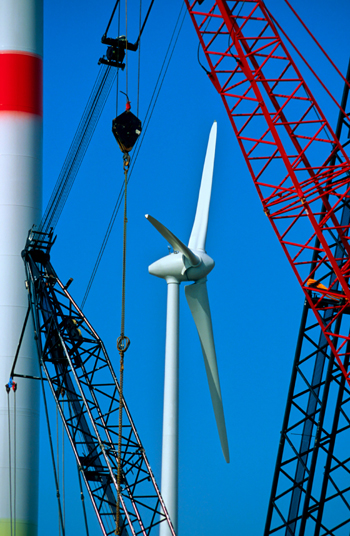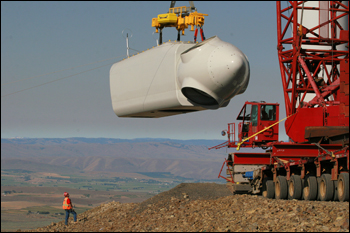Green Job Hazards
Wind Energy: Crane, Derrick and Hoist Safety
Cranes, derricks, and hoists will be used to move the large, heavy loads during wind turbine installation and maintenance. Fatalities and serious injuries can occur if cranes are not inspected and used properly. Many fatalities can occur when the crane boom, load line or load contacts power lines and shorts electricity to ground. Other incidents happen when workers are struck by the load, are caught inside the swing radius or fail to assemble/disassemble the crane properly. There are significant safety issues to be considered, both for the operators of the diverse "lifting" devices, and for workers who work near them. See OSHA’s General Industry standards at 29 CFR 1910.179 and 29 CFR 1910.180, and Construction standard at 29 CFR 1926.1417 for specific crane requirements.
-
Cranes are to be operated only by qualified and trained personnel.
-
A designated competent person must inspect the crane and all crane controls before use.
-
Be sure the crane is on a firm/stable surface and level.
-
During assembly/disassembly do not unlock or remove pins unless sections are blocked and secure (stable).
-
Fully extend outriggers and barricade accessible areas inside the crane’s swing radius.
-
Watch for overhead electric power lines and maintain at least a 10-foot safe working clearance from the lines.
-
Inspect all rigging prior to use; do not wrap hoist lines around the load.
-
Be sure to use the correct load chart for the crane’s current configuration and setup, the load weight and lift path.
-
Do not exceed the load chart capacity while making lifts.
-
Raise load a few inches, hold, verify capacity/balance, and test brake system before delivering load.
-
Do not move loads over workers.
- Be sure to follow signals and manufacturer instructions while operating cranes.
Since Wind Turbines are installed in windy areas, the affects of wind speeds need to be taken into consideration for lifting activities. Stability can be an issue when the boom is high and the wind coming from the rear, front, or side of the crane can cause the load to sway away from the crane, increasing the radius and thus possibly decreasing the crane capacity.
An employer needs to determine the wind speeds at which it is not safe to continue lifting operations. Load charts do not generally take wind speeds into consideration. If the load chart or the operating manual does not have information on wind speeds and derating information, the crane manufacturer should be consulted. The procedures applicable to the operation of the equipment, including rated capacities (load charts), recommended operating speeds, special hazard warnings, instructions, and operator’s manual, must be readily available in the cab at all times for use by the operator. See 29 CFR 1926.1417(c). The maximum allowable wind speed and derating information need to be posted conspicuously in the cab or on the load chart
Extremely cold weather conditions can have an impact on crane and lifting operations. When temperatures drop below 10o F appropriate consideration should be given to crane hydraulics, and possible derating of the crane.
Bad weather such as rain, snow or fog, can also have adverse impact on lifting. Equipment and/or operations must be adjusted to address the effect of wind, ice, and snow on equipment stability and rated capacity. See 29 CFR 1926.1417(n). During thunderstorms, a crane boom can become a lightning rod. If there is an indication of possible thunderstorms, lifting activities should be suspended and the boom should be lowered to a safe position, and workers should leave the area. If the crane is struck by lightning, it should be thoroughly inspected prior to putting it back into service.
Heavy rain along with high speed winds also can affect crane operations. Water can get into components such as brakes or clutches, and render them inoperable. When these conditions exist, operators should wait until the components are dried out.
The following resources are available:



